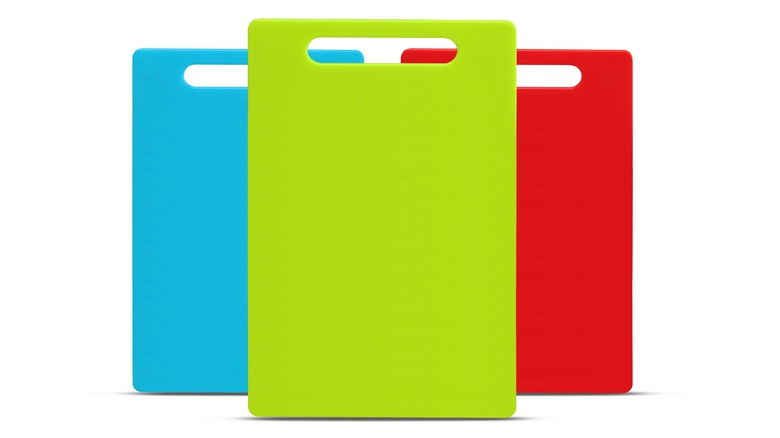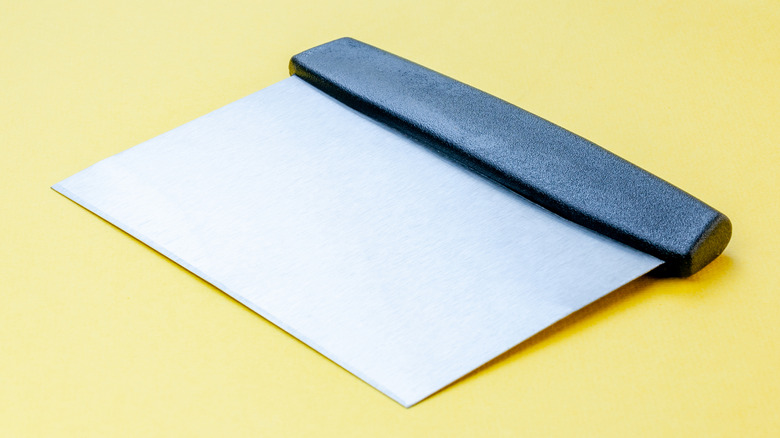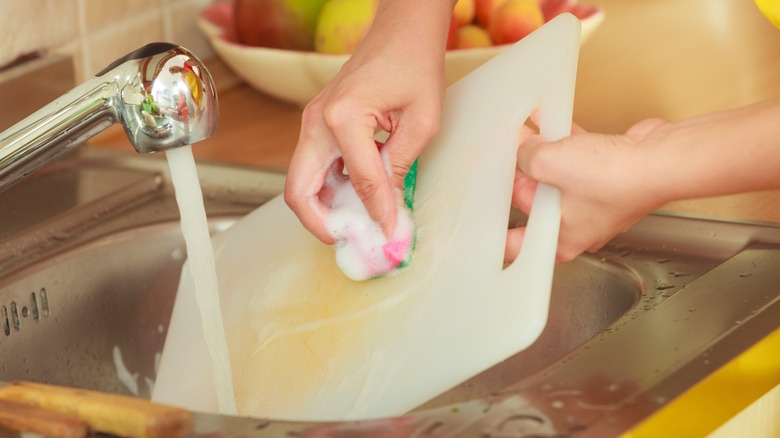The Pastry Tool Perfect For Safely Washing Plastic Cutting Boards
No matter what dish you're tackling in the kitchen, the odds are good that you'll need the services of a cutting board at some point. From deboning a chicken breast to thinly slicing a tomato, these tools are irreplaceable when prepping food. However, over time, all that chopping and dicing will cut small channels into the surface of the board, creating a haven for bacteria to flourish. To keep your kitchen sanitary, it's essential to thoroughly wash cutting boards every time they're used.
As part of the washing process, cutting boards need to be scraped to prevent food from becoming stuck in the worn grooves. Using a knife for this task will quickly dull the blade and likely do damage to the cutting board surface as well. Instead, try using a pastry scraper. Designed to cut and manage dough, these rigid utensils come in a variety of materials and sizes and are perfect for scouring the surface of a dirty cutting board. They are gentle enough to avoid damage to the board's finish but strong enough to effectively clean off residual food debris.
How to use a pastry scraper to clean your cutting board
Pastry scrapers come in many different shapes and sizes, not all of which will be appropriate for cleaning. Metal scrapers are typically rectangular, with a handle on one side and a blunt, rigid edge on the other. While they aren't sharpened like a knife blade, these scrapers are designed to cut soft foods — like dough — and have a firm edge. The edge is strong enough to effectively clear any food bits off the surface of the board and out of those bacteria-harboring ruts. Simply run the hard edge at an angle down the surface of the board.
Plastic scrapers are often curved instead of rectangular. Like their metal cousins, these tools hold a firm edge. However, they're usually crafted with a softer plastic, like silicone. Because they're curved, plastic scrapers aren't quite as effective at covering the flat surface of a cutting board, but they are useful for targeting the rounded juice grooves found on many board perimeters. You'll have a difficult time scraping these troughs with a rectangular scraper, but a D-shaped edge can easily reach into these areas. Some pastry scrapers have both a curved and a straight edge, making them the perfect all-in-one tool for scraping any cutting board.
Finish off with a thorough wash
After a good scraping, your boards are ready to be washed. However, you should think twice before running your cutting boards through the dishwasher, especially if they're made of wood. The high heat during a wash cycle can easily warp and even crack the wood, reducing the board's quality and longevity. If they're thick, plastic cutting boards are generally able to withstand the heat of the dishwasher. However, thinner plastics may warp or even melt when exposed to high heat. To be safe, you can always handwash your cutting boards with a simple liquid dish soap and some warm water.
Sometimes, a dirty cutting board needs more than a quick rinse. For particularly gnarly stains, you can try the baking soda trick to revive your cutting board. Start by sprinkling a healthy amount of baking soda over the surface of a dirty board. Then, cut a lemon in half and squeeze juice over the baking soda. Finally, use the lemon itself to scrub the mixture onto the surface of the board. While this trick isn't effective at removing bacteria (you'll want to stick to dish soap and cleaning agents for that), it will remove any gunk and give your cutting board a new shine.


